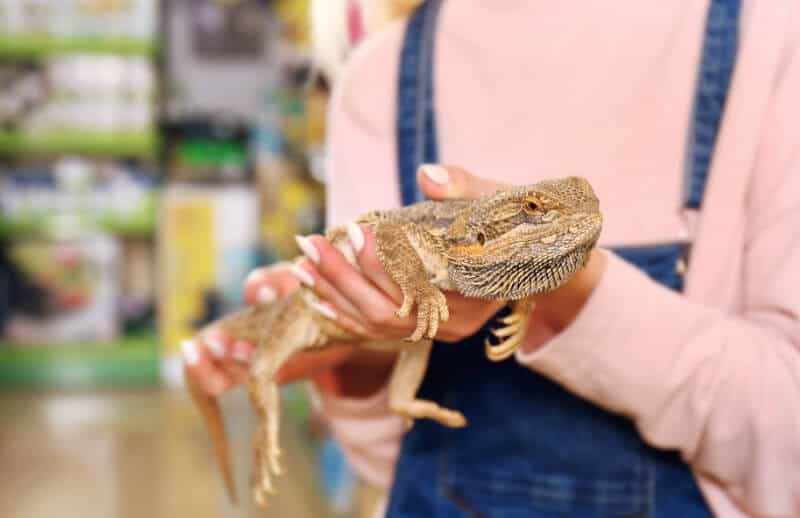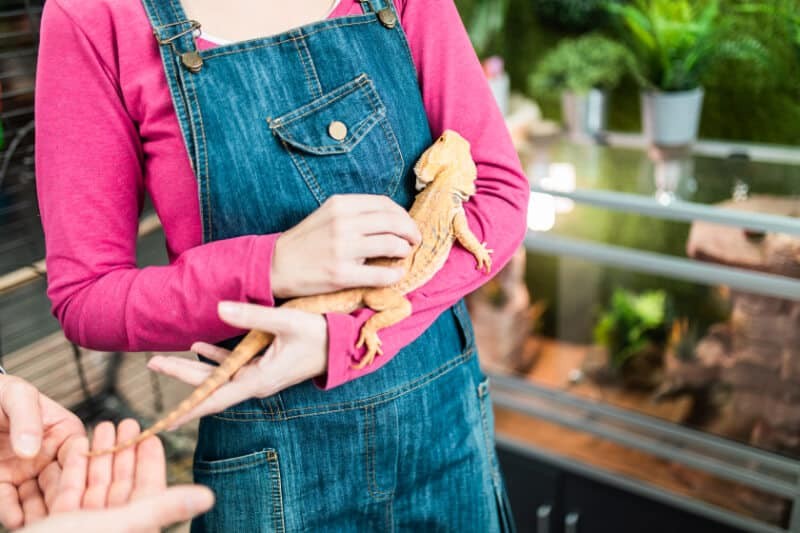Where Do Bearded Dragons Like To Be Petted? It’s a question many new and experienced reptile owners ask. At PETS.EDU.VN, we understand that knowing where your bearded dragon enjoys being petted is crucial for building a strong, positive bond with your scaly friend. This guide provides comprehensive insights into petting preferences, ensuring happy and healthy interactions. Discover how to create a loving and stress-free environment for your bearded dragon!
1. Understanding the Bearded Dragon’s Personality
Bearded dragons, scientifically known as Pogona vitticeps, are popular pets due to their docile nature and unique personalities. However, understanding their individual preferences is key to a harmonious relationship.
1.1. Solitary Creatures by Nature
In the wild, bearded dragons are solitary animals. They don’t seek companionship and often live alone. This solitary nature influences how they perceive physical contact.
1.2. Socialization Matters
Bearded dragons can become accustomed to human touch through consistent, gentle socialization, especially when they are young. Early, positive interactions can help them tolerate and even enjoy being petted.
1.3. Unique Personalities
Each bearded dragon has its own distinct personality. Some may be more receptive to petting than others. Patience and observation are essential to understanding your pet’s preferences.
2. Decoding Your Bearded Dragon’s Body Language
Learning to read your bearded dragon’s body language is essential to understanding whether they enjoy being petted at any given moment.
2.1. Signs of Relaxation
A relaxed bearded dragon will exhibit calm and still behavior. Look for the following signs:
- Closed mouth (often resembling a smile)
- Open, dilated eyes
- Relaxed breathing
- Calm posture
2.2. Positive Indicators
- Meeting you at the glass: If your bearded dragon approaches the enclosure glass when you come near, it’s a sign they are comfortable with your presence.
- Rubbing against your fingers: Some dragons will rub against your fingers, indicating they enjoy and expect petting.
2.3. Signs of Discomfort or Stress
Recognizing signs of discomfort is crucial to avoid stressing your pet. Here are some indicators they do not want to be petted:
- Hissing
- Puffing up their body
- Expanding their beard
- Running away
- Trying to wriggle free
- Burrowing
- Glass surfing (flinging themselves against the glass)
- Arm waving
- Mouth open
- Head bobbing
- Closing eyes (bracing for discomfort, not necessarily enjoying the interaction)
2.4. Aggressive Behavior
Any form of aggressive behavior is a clear indication that your bearded dragon wants to be left alone. Respect their boundaries to maintain trust.
3. The Right Way to Pet a Bearded Dragon
Proper technique is essential to ensure your bearded dragon feels safe and comfortable during petting sessions.
3.1. Hygiene First
Always wash your hands thoroughly with soap and water before and after handling your bearded dragon to prevent the spread of bacteria.
3.2. Timing is Key
Avoid disturbing your bearded dragon while they are sleeping or right before or after feeding. Choose a time when they are alert and relaxed.
3.3. Approach with Care
Approach your bearded dragon slowly and from the front. Never approach them from behind, as this can startle them.
3.4. Gentle Touch
Use only one or two fingers to pet your bearded dragon. Avoid using your entire hand, which can be overwhelming. Apply very light pressure.
3.5. Direction Matters
Gently run your fingers from their head to their tail. Avoid petting in the opposite direction, as this can be uncomfortable.
4. Favorite Petting Spots on a Bearded Dragon
While every bearded dragon is unique, some general areas are often enjoyed more than others.
4.1. Head
Most bearded dragons enjoy gentle petting on their heads. However, always approach from the front so they know you’re coming. Avoid squeezing or applying too much pressure.
4.2. Nose
After petting the head, you can gently move down to the nose. Be careful to avoid the mouth and eyes.
4.3. Back
If your bearded dragon enjoys head pets, they will likely enjoy gentle strokes along their back. Pet in one direction, from head to tail.
4.4. Tail
Some bearded dragons enjoy a light tail stroke. Start from the head and gently pet down to the tail. Avoid grabbing or pulling the tail.
4.5. Belly
Petting the belly is tricky. Never force your bearded dragon onto their back. If you have an opportunity to touch the belly, do so briefly and observe their reaction.
5. How Much Petting Is Too Much for Bearded Dragons?
While it’s tempting to shower your bearded dragon with affection, moderation is key.
5.1. Observe Limits
Bearded dragons typically tolerate handling and petting for about one to two hours a day. Anything more may cause them stress.
5.2. Shorter Sessions
Instead of one long session, break petting into 10-15 minute intervals. Observe your dragon’s body language to determine if they are still comfortable.
5.3. Respect Boundaries
Always stop petting if your bearded dragon shows any signs of discomfort or stress. Respecting their needs builds trust.
6. Pros and Cons of Regular Petting for Bearded Dragons
Consider the benefits and risks of regular petting to make informed decisions about interacting with your bearded dragon.
6.1. Pros of Petting
- Bonding: Petting is a fantastic way to build trust and strengthen your bond with your bearded dragon.
- Socialization: Regular human contact can make your dragon more comfortable around people, reducing stress.
- Health Monitoring: Petting allows you to closely observe your dragon’s body, making it easier to spot potential health issues early.
- Easier Maintenance: A bearded dragon accustomed to handling makes tank maintenance easier.
6.2. Cons of Petting
- Spread of Disease: Bearded dragons can carry Salmonella. Always practice good hygiene.
- Shedding Problems: Disrupting the shedding process can cause issues. Avoid petting during shedding.
- Stress: Ignoring warning signs can lead to stress and anxiety.
7. Understanding Sensory Perception in Bearded Dragons
Bearded dragons can feel your touch through sensory receptors in their skin. This is why it’s crucial to be gentle. They can feel pain if too much pressure is applied.
7.1. Gentle Approach
A gentle, consistent approach will make your bearded dragon more comfortable with being petted over time.
8. Creating a Positive Petting Experience
Creating a positive petting experience involves understanding your bearded dragon’s needs and preferences.
8.1. Consistency
Regular, gentle interactions help your dragon become more comfortable with human touch.
8.2. Environment
Ensure the environment is calm and quiet to minimize stress.
8.3. Positive Reinforcement
Use positive reinforcement, such as offering a favorite treat after a petting session, to create positive associations.
9. Addressing Common Concerns
New owners often have questions about petting their bearded dragons. Here are some common concerns and answers.
9.1. Is my bearded dragon always going to like being petted?
Not necessarily. Their tolerance can vary based on mood, health, and environment. Pay attention to their body language.
9.2. What if my bearded dragon never seems to enjoy petting?
Some bearded dragons may never enjoy being petted. Respect their preferences and find other ways to bond.
9.3. Can I introduce petting to an older bearded dragon?
Yes, but it may take more time and patience. Start slowly and be very gentle.
9.4. How do I handle a bearded dragon that bites?
Avoid startling them. Always approach from the front and respect their space. Seek advice from a reptile veterinarian or experienced keeper if biting persists.
10. Expert Insights from PETS.EDU.VN
At PETS.EDU.VN, we are dedicated to providing the latest, most accurate information to help you care for your pets. Our team of experts continuously researches and updates our resources to ensure you have the knowledge you need.
10.1. The Importance of Continued Learning
Caring for a bearded dragon is an ongoing learning process. Stay informed about their needs and behaviors.
10.2. Discover More at PETS.EDU.VN
For more in-depth information on caring for your bearded dragon, explore our extensive library of articles, guides, and resources. From diet and habitat to health and behavior, we’ve got you covered.
11. Advanced Techniques for Building a Stronger Bond
Building a strong bond with your bearded dragon goes beyond just petting. Incorporate these advanced techniques for a deeper connection.
11.1. Hand Feeding
Offering your bearded dragon food from your hand can build trust. Start with their favorite treat and be patient.
11.2. Creating a Stimulating Environment
A stimulating environment keeps your bearded dragon engaged and happy. Provide climbing structures, hiding spots, and opportunities for exploration.
11.3. Regular Interaction
Even if your bearded dragon doesn’t enjoy petting, regular interaction is important. Spend time near their enclosure, talk to them, and let them get used to your presence.
12. The Role of Diet and Health in Petting Tolerance
A healthy, well-fed bearded dragon is more likely to be receptive to petting. Ensure they receive proper nutrition and veterinary care.
12.1. Balanced Diet
A balanced diet is essential for your bearded dragon’s health and well-being. Offer a variety of insects, vegetables, and fruits.
12.2. Regular Vet Check-ups
Regular check-ups with a reptile veterinarian can help identify and address any health issues that may affect their behavior.
12.3. Supplementation
Ensure your bearded dragon receives appropriate vitamin and mineral supplementation to support their overall health.
13. Optimizing the Enclosure for Comfort and Security
A comfortable and secure enclosure can reduce stress and increase your bearded dragon’s willingness to interact.
13.1. Proper Temperature Gradient
Provide a proper temperature gradient within the enclosure, allowing your bearded dragon to thermoregulate.
13.2. Adequate Hiding Spots
Ensure they have plenty of hiding spots to retreat to when they feel stressed or overwhelmed.
13.3. UV Lighting
Provide adequate UVB lighting to support their health and well-being.
14. Understanding the Impact of Seasonal Changes
Seasonal changes can affect your bearded dragon’s behavior and tolerance for petting.
14.1. Brumation
During brumation, bearded dragons become less active and may not want to be disturbed. Respect their need for rest.
14.2. Temperature Fluctuations
Adjust the enclosure temperature to accommodate seasonal changes.
14.3. Monitoring Behavior
Pay close attention to your bearded dragon’s behavior during seasonal changes and adjust your interactions accordingly.
15. Addressing Specific Behavioral Issues
Some bearded dragons may exhibit specific behavioral issues that affect their tolerance for petting.
15.1. Aggression
If your bearded dragon is aggressive, seek advice from a reptile veterinarian or experienced keeper.
15.2. Fearfulness
If your bearded dragon is fearful, take a slow and patient approach to socialization.
15.3. Stress-Related Behaviors
Identify and address any stressors in your bearded dragon’s environment.
16. The Latest Research on Reptile Behavior
Stay updated on the latest research on reptile behavior to better understand your bearded dragon’s needs and preferences.
16.1. Scientific Studies
Read scientific studies on reptile behavior to gain insights into their cognitive abilities and emotional lives.
16.2. Expert Opinions
Seek out the opinions of reptile experts and researchers.
16.3. Community Forums
Participate in online forums and communities to learn from other bearded dragon owners.
17. The Future of Bearded Dragon Care
The field of reptile care is constantly evolving. Stay informed about new advancements and techniques.
17.1. Technological Innovations
Explore new technological innovations in reptile care, such as automated enclosure systems and advanced diagnostic tools.
17.2. Ethical Considerations
Consider the ethical implications of keeping reptiles as pets.
17.3. Conservation Efforts
Support conservation efforts to protect wild reptile populations.
18. Frequently Asked Questions (FAQ) About Petting Bearded Dragons
Here are some frequently asked questions about petting bearded dragons:
18.1. Where is the best place to pet a bearded dragon?
Most bearded dragons enjoy gentle petting on their heads and backs.
18.2. How can I tell if my bearded dragon likes being petted?
Look for signs of relaxation, such as a closed mouth and open eyes.
18.3. How often should I pet my bearded dragon?
Limit petting sessions to 10-15 minutes at a time.
18.4. Can I pet my bearded dragon every day?
Yes, but always pay attention to their body language.
18.5. What should I do if my bearded dragon doesn’t like being petted?
Respect their preferences and find other ways to bond.
18.6. Is it safe to let children pet my bearded dragon?
Yes, but always supervise them closely.
18.7. Can petting help reduce stress in bearded dragons?
If done correctly, petting can help reduce stress.
18.8. How long does it take for a bearded dragon to get used to being petted?
It varies depending on the individual dragon.
18.9. What are the signs of stress in bearded dragons?
Signs of stress include hissing, puffing up, and running away.
18.10. Can bearded dragons feel pain when being petted?
Yes, so always be gentle.
19. Real-Life Examples of Positive Petting Experiences
Hearing from other bearded dragon owners can provide valuable insights and inspiration.
19.1. Owner Testimonials
Read testimonials from bearded dragon owners who have successfully built positive relationships with their pets.
19.2. Case Studies
Explore case studies of bearded dragons who have overcome behavioral issues and learned to enjoy being petted.
19.3. Success Stories
Share your own success stories to inspire others.
20. Conclusion: Building a Loving Bond with Your Bearded Dragon
Understanding where bearded dragons like to be petted is an important part of responsible pet ownership. By learning to read your dragon’s body language, using proper petting techniques, and respecting their boundaries, you can create a loving, trusting relationship.
At PETS.EDU.VN, we’re committed to providing you with the knowledge and resources you need to give your bearded dragon the best possible care. Explore our website for more information, and don’t hesitate to contact us with any questions.
For more expert tips and resources on bearded dragon care, visit PETS.EDU.VN today!
Contact us:
- Address: 789 Paw Lane, Petville, CA 91234, United States
- WhatsApp: +1 555-987-6543
- Website: PETS.EDU.VN
21. Comprehensive Table: Petting Preferences and Considerations
| Body Part | Likelihood of Enjoyment | How to Pet | Considerations |
|---|---|---|---|
| Head | High | Gentle strokes, front approach | Avoid squeezing, ensure the dragon sees you approaching |
| Nose | Moderate | Very gentle touch, upward stroke | Avoid eyes and mouth |
| Back | High | Smooth, one-way strokes (head to tail) | Be consistent, avoid back-and-forth motion |
| Tail | Moderate | Light strokes from base to tip | Avoid grabbing or pulling, observe reaction closely |
| Belly | Low | Only if dragon is comfortable and exposed | Never force the dragon on its back, brief touch only |
| Legs | Very Low | Generally avoided unless medically necessary | Handle with extreme care, typically only for health-related reasons (e.g., applying medication), ensure gentle and secure support. |
| Beard | Avoid | Sensitive area, can cause stress | It is best to completely avoid touching their beard, as it can be a source of significant stress. The beard is used for communication, and touching it can be misread as a challenge or threat. |
| Eyes | Avoid | Extremely sensitive, causes discomfort | Never touch the eyes, as it can cause injury or irritation. |
| Mouth | Avoid | Can result in bites | Keep fingers away from the mouth |
| Vent (Cloaca) | Avoid | Very sensitive, causes stress | Avoid this area unless medically necessary, as any handling can be extremely stressful and is only appropriate when required for health reasons performed by a vet. |
| Feet | Avoid | Can cause stress | Avoid, unless there is a need to examine them |


22. New Advances in Understanding Reptilian Comfort
Recent studies have shed light on how reptiles perceive and respond to touch, providing new insights into creating comfortable interactions with your bearded dragon.
22.1. Skin Sensitivity Mapping
Researchers are creating detailed “sensitivity maps” of reptile skin, identifying areas that are most receptive to touch. This research helps owners target petting to areas where it is most likely to be enjoyed.
22.2. Behavioral Analysis Technology
Advanced video analysis tools are being used to objectively measure reptile behavior during petting sessions. These tools can detect subtle signs of stress or relaxation that might be missed by the human eye.
22.3. Physiological Monitoring
Wearable sensors are being developed to monitor physiological indicators of stress and comfort in reptiles, such as heart rate and body temperature. This technology can provide real-time feedback on how a bearded dragon is responding to petting.
23. The Importance of Enrichment and Mental Stimulation
A bored bearded dragon is more likely to be stressed and less receptive to petting. Provide plenty of enrichment to keep your pet mentally stimulated.
23.1. Puzzle Feeders
Use puzzle feeders to make mealtime more challenging and engaging.
23.2. Climbing Structures
Provide climbing structures, such as branches and rocks, to encourage exercise and exploration.
23.3. Novel Objects
Introduce novel objects into the enclosure regularly to keep your bearded dragon curious.
24. The Ethical Considerations of Petting Reptiles
As responsible pet owners, it’s important to consider the ethical implications of our interactions with reptiles.
24.1. Respecting Autonomy
Reptiles are sentient beings with their own needs and preferences. Respect their autonomy by allowing them to choose whether or not they want to be petted.
24.2. Avoiding Anthropomorphism
Avoid attributing human emotions and motivations to reptiles. Understand their behavior from a reptile-centric perspective.
24.3. Promoting Welfare
Prioritize the welfare of your reptile by providing a comfortable and enriching environment.
25. Conclusion: A Compassionate Approach to Petting
Building a positive relationship with your bearded dragon requires patience, understanding, and compassion. By learning to read their body language, respecting their boundaries, and providing a stimulating environment, you can create a loving bond that benefits both you and your pet.
Remember to visit PETS.EDU.VN for more expert tips and resources on caring for your bearded dragon.
For more expert tips and resources on bearded dragon care, visit PETS.EDU.VN today!
Contact us:
- Address: 789 Paw Lane, Petville, CA 91234, United States
- WhatsApp: +1 555-987-6543
- Website: pets.edu.vn
